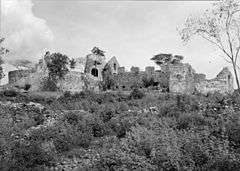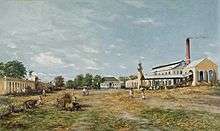Sugar plantations in the Caribbean


Sugar was the main crop produced on plantations throughout the Caribbean through the 18th, 19th, and 20th centuries. Most islands were covered with sugar cane and mills for refining it. The main source of labor, until the abolition of the system, was African slaves. These plantations produced 80 to 90 percent of the sugar consumed in Western Europe.
The sugar trade
Sugar was the most important crop throughout the Caribbean, although other crops such as coffee, indigo, and rice were also grown. Sugar cane was best grown on relatively flat land that was near the coast, where the soil was naturally yellow and fertile; mountainous parts of the islands were less likely to be used for cane cultivation.
In the mid-17th century, sugar cane was brought into what later became the British West Indies by the Dutch,[1][2][3] from Brazil. Upon landing in Barbados and other islands, they quickly urged local growers to change their main crops from cotton and tobacco to sugar cane. With depressed prices of cotton and tobacco, due mainly to stiff competition from the North American colonies, the farmers switched, leading to a boom in the Caribbean economies. Sugar was quickly snapped up by the British, who used it in cakes and to sweeten teas.
During the colonial period, the arrival of sugar culture deeply impacted the society and economy in the Caribbean. It not only dramatically increased the ratio of slaves to free men, but it increased the average size of slave plantations. Early sugar plantations made extensive use of slaves because sugar was considered a cash crop that exhibited economies of scale in cultivation; it was most efficiently grown on large plantations with many workers. As a result, black men and women were forcibly taken from Africa and made into slaves to work on the plantations. For example, before 1650 more than three-quarters of the islands' population was white. In 1680, the median size of a plantation in Barbados had increased to about 60 slaves. Over the decades, the sugar plantations became larger and larger. In 1832, the median-size plantation in Jamaica had about 150 slaves, and nearly one of every four bondsmen lived on units that had at least 250 slaves.[4]

For about 100 years, Barbados remained the richest of all the European colonies in the Caribbean. The colony's prosperity remained regionally unmatched until sugar cane production expanded in larger countries, such as Saint Domingue and Jamaica. As part of the mass sugar industry, sugar cane processing gave rise to related commodities such as rum, molasses, and falernum.
The West India Interest was formed in the 1740s, when the British merchants joined with the West Indian sugar planters. The British and West Indies shared profits and needs. This organization was the first sugar-trading organization which had a large voice in Parliament.
In the 1740s, Jamaica and Saint Domingue (Haiti) became the world’s main sugar producers. They increased production in Saint Domingue by using an irrigation system that French engineers built. The engineers also built reservoirs, diversion dams, levees, aqueducts, and canals. In addition, they improved their mills and used varieties of cane and grasses.
After the end of slavery in Saint Domingue at the turn of the 19th century, with the Haitian Revolution, Cuba became the most substantial sugar plantation colony in the Caribbean, outperforming the British islands.
In the 19th century, sugar dominated Martinique, Grenada, Jamaica, Saint Croix, Barbados, Leeward Islands, Saint Domingue, Cuba, and many other islands that had been run by French, British, or Spanish owners. During the late 19th and 20th centuries, the sugar cane industry came to dominate Puerto Rico's economy, both under the colonial rule of Spain and under the United States.
After slavery, sugar plantations used a variety of forms of labour including workers imported from India under contracts of indenture (see coolie). In the 20th century, large-scale sugar production using wage labour continued in many parts of the region.
Current status
By the early 21st century, many Caribbean islands were no longer producing sugar. However, sugar is still grown in Jamaica and Cuba, among other countries.
See also
- Trapiche, a mill used for sugar cane
- Colonial molasses trade
- Sugar production in the Danish West Indies
- Slavery in the British and French Caribbean
- Valle de los Ingenios - Valley of the Sugar Mills, Cuba
| Wikimedia Commons has media related to Sugar production in the Caribbean. |
References
- ↑ Nancy sharkey, "A Barbados Synagogue Is Reborn", New York Times, December 11, 1988
- ↑ "Top Tourist Attractions in Bridgetown".
- ↑ Ralph G.Bennett, History of the Jews of the Caribbean
- ↑ Robert William Fogel, “Slavery in the New World”. Without Consent or Contract: The Rise and Fall of American Slavery. p 21-23
.jpg)
